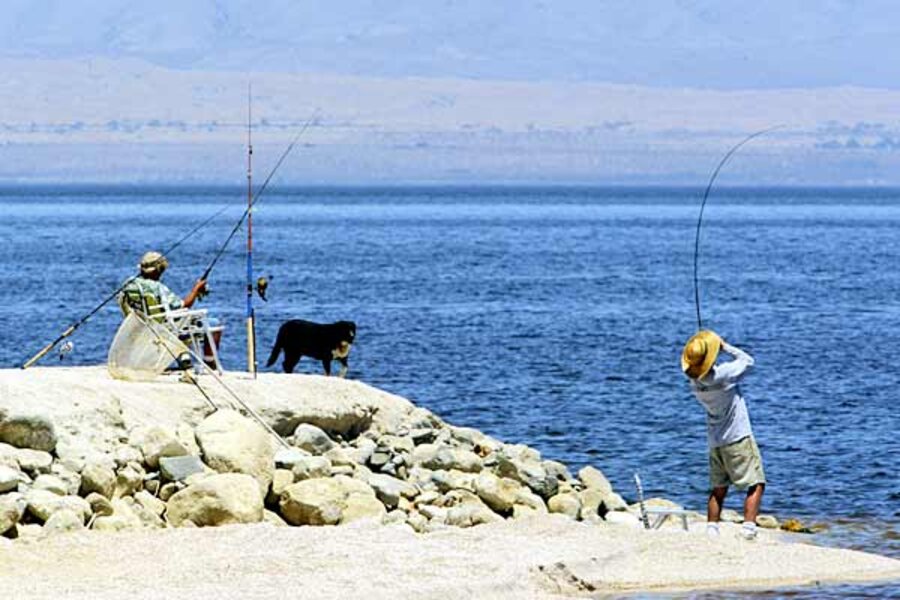Saga of California's Salton Sea: a tragic chapter ahead?
Loading...
| Los Angeles
California's Salton Sea hasn't been looking too good for some time, and now environmentalists are concerned that conditions at this salty inland "sea" are about to get much worse.
Their big worry: that the body of water, created during a huge flood in 1905 in which distant Colorado River water coursed into a desert basin, will shrink much faster in coming years than it has been. As the shallow lake dries out, contaminants from decades of agricultural runoff – such as selenium and arsenic – will be exposed and, whipped by high winds, carried far afield, threatening the health of people and wildlife. Several species of migratory birds along the Pacific Flyway will also be threatened, environmentalists warn.
Why are they expecting this accelerated shriveling of the Salton Sea? A big water diversion system is slated to transfer water now used locally for farming to the south, in San Diego County, for use by city-dwellers.
That ag runoff, plus whatever rainfall materializes, are what replenish the saline lake. If area farmers use less water, the reasoning goes, there will be less runoff into the Salton Sea, and it will shrink dramatically. Last month, the California Supreme Court gave the go-ahead to the water transfer plan.
“This is a ticking time bomb that without significant public intervention is going to cause major harm to public health and wildlife,” says Dan Taylor, executive director of California Audubon Society, which has been following the situation for years.
Of course, there's a plan to mitigate the loss of farm irrigation water that now goes to the San Diego County Water Authority. Money from the SDCWA will be used to pay farmers to leave some acres fallow, and some of the water that would have been used to irrigate those acres will instead be dedicated to filling Salton Sea.
The plan "fully mitigates" water the local irrigation district now will send to urban dwellers to the south, Halla Razak, Colorado River Program director for the SDCWA, told the Huffington Post recently. The overarching water transfer plan, known as the Quantification Settlement Agreement, is intended to reduce statewide dependence on water from the Colorado River.
But because the fallowing program is voluntary among farmers, some doubt it will yield enough water to prevent the Salton Sea from drying up – perhaps in a matter of years.
The Salton Sea is already in rough shape. Technically, it's a lake – California's largest. Because it has no outflow, concentrations of chemicals and salts have increased through the years, as has the lake's salinity. The problems have killed millions of fish and driven away most recreationalists and resort owners.
But migrating birds still flock to the 381-square-mile body of water, which Mr. Taylor says "in the league of global importance" because of the diversity of species and the size of the bird population there. If the lake is allowed to disappear, he says, several species of migrating birds could go extinct, multiplying the effects of recent die-offs such as white pelicans and cormorants.
If environmentalists see impending disaster, scholars see opportunity to learn lessons that can be applied elsewhere.
“The Salton Sea’s slow death offers an opportunity to interrogate our national priorities and to see how they correlate with our actions,” says Pace Law School Prof. David Cassuto, who specializes in water law, legal and environmental theory, in an e-mail. “It was created by accident, only to evolve into an important ecological priority and a slow-motion environmental disaster.”
Professor Cassuto, director of the Brazil-American Institute of Law & Environment, says he realizes “an inland sea created from contaminated agricultural runoff is a tough sell for environmental preservation, but the consequences to both humans and the environment from its demise will be immense.”
In addition to asking whether, how, and if it can be saved, he says, perhaps “we should also be asking why and how we got into this situation. What does it say about our environmental laws and policies that if we do not preserve what amounts to a toxin-filled, hyper-saline flood, we risk an even greater environmental catastrophe?”
Farmer Jack Vessey, who owns 10,000 acres in the area and grows winter vegetables, says farmers were told the state would take care of environmental mitigation if farmers went along with allowing San Diego to have the irrigation water.
"We went along slowly," he says in a phone interview, "and now we're feeling misled." Gov. Jerry Brown (D) had a proposal to cut funding to the Salton Sea Restoration Council, which is charged with leading the sea's ecological restoration. They supported it because they felt it would allow more local control.
But now Mr. Vessey worries that he and other farmers in the area could be on the hook for mitigation payments to keep the Salton Sea, well, wet. The lake doesn't have to be reduced to a dry bed for problems to arise, he says.
“Just a drop of six inches and you already have major problems with dust storms blowing up selenium and salt, threatening people’s health and adding salt to the ground," he says. "Farmers were told that the state was going to take care of environmental mitigation if this went through. Now everyone’s talking to lawyers and no one can get a straight answer on what will happen.”





